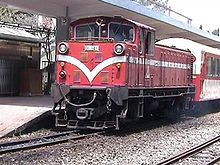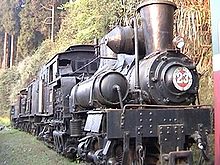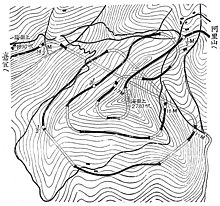Alishan Forest Railway
The Alishan Forest Railway ( Chinese 阿里山 森林 鐵路 , English Alishan Forest Railway ) is a narrow-gauge forest railway in Taiwan from Chiayi to the mountain community of Alishan with the mountains of the same name . It has a length of around 86 km. The longest section leads from Chiayi in the western Taiwanese lowlands (30 m above sea level) up to the mountain region of the Alishan Mountains at 2,274 meters above sea level. An outstanding specialty is that it is a pure adhesion track , so that no gear or rack and pinion technology is used even on the steepest sections of the route .
The track has a track width of 762 mm. It was built by the government in 1912 during the Japanese rule over Taiwan (1895–1945) . It was primarily used in freight transport to transport trunks of the cypress trees (Red Cyprus) growing on the summit - some of which are over 5000 years old - down into the valley. From there the logs were transported by ship to Japan in order to make - very expensive - furniture.
Today, the small train transports mainly tourists from Taiwan and Japan from the subtropical zone (Chiayi 30 m) through a moderate climate up to the cool - alpine - region of the mountain "Ali" ("Holy Mountain").
A special feature of this railway is the route in the middle area, which spirals up the steep mountain slopes.
After the railway was under the forest authorities for decades and was also operated by them, in 2008 the "HungTu AliShan International Co., Ltd" (a company originally active in the construction industry) leased the equipment and vehicles for 50 years and tried to keep them running of hotels to offer a tourism offer “from a single source”. However, the change from state custody to private enterprise resulted in new problems, for example steam locomotive operation was not possible due to new regulations. Since 2010 the railway has been under the state forest administration again.
Vehicle use
Operated the trains with small diesel locomotives with rod drive of Mitsubishi , which have been specially made for this operation and some with Cummins - diesel engines are equipped of about 750 hp. Locomotives with a total weight of 18 to 25 t are used on the lower sections of the route, while the higher sections are served by 29 t locomotives.
In addition to several parked steam locomotives (Shay locomotives , built by the American company LIMA Locomotive Works in Ohio) there are also two operational steam locomotives with the numbers 26 and 31, which were converted from coal to oil firing in 2008. The reason for the conversion was the risk of fire from flying sparks with coal firing, which required an unacceptable expense. However, the converted locomotives can no longer be found in regular operation and, due to the very low fuel supply of only 500 ltr. Diesel oil can technically no longer be used as the sole towing vehicle on the route (in times of coal traction there was a possibility to refill coal and water at every intermediate station). The aforementioned change of operator in 2008 brought with it a number of regulatory changes, so that it is currently unclear when one or both operable locomotives will be heated up again - Locomotive 31 is in the Alishan depot in April 2009 and has not been moved for almost a year .
The severe earthquake in 1999 not only destroyed the "New Alishan Station", which had only recently been built, but also some parts of the route in the upper area of the Alishan Mountains, such as parts of the approximately 8 km long section from Alishan station to the earthquake Monkey rock. Repair work is constantly in progress.
Typhoon in August 2009
After the severe typhoon in August 2009, the route from Chiayi to Alishan was not continuously passable, but rather interrupted by a landslide at about 530 m above sea level. The line from Chiayi station to Fenchihu station has been restored since 2015. From there, shuttle buses drive the rest of the way to the Alishan Mountains.
Accidents
On March 1, 2003, a passenger train derailed on a bridge. 19 people died and over 100 others were seriously injured.
literature
- William D. Middleton: The Shays of Ali Shan . In: Trains . 02/78, Kalmbach Publishing Co., pp. 48-51, ISSN 0041-0934
Web links
- Official website ( Memento of October 15, 2008 in the Internet Archive ) (English version)
- David Momphard / Tilman Aretz: Taiwan's Mountain Railway , detailed report in T @ iwan today, October 28, 2005
Individual evidence
- ↑ Swiss Railway Review 4/2003 page 179.





